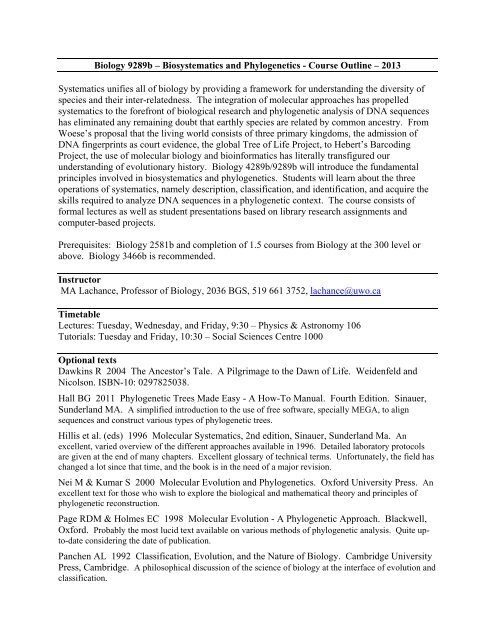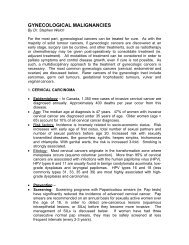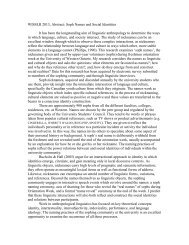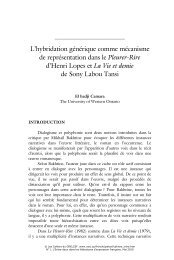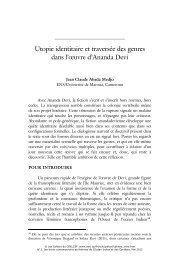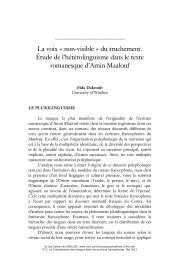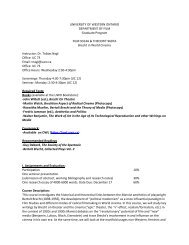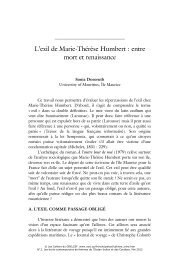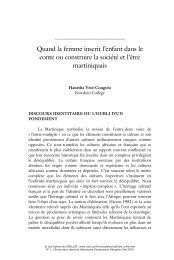Biology 9289b – Biosystematics and Phylogenetics - Course Outline ...
Biology 9289b – Biosystematics and Phylogenetics - Course Outline ...
Biology 9289b – Biosystematics and Phylogenetics - Course Outline ...
Create successful ePaper yourself
Turn your PDF publications into a flip-book with our unique Google optimized e-Paper software.
<strong>Biology</strong> <strong>9289b</strong> <strong>–</strong> <strong>Biosystematics</strong> <strong>and</strong> <strong>Phylogenetics</strong> - <strong>Course</strong> <strong>Outline</strong> <strong>–</strong> 2013<br />
Systematics unifies all of biology by providing a framework for underst<strong>and</strong>ing the diversity of<br />
species <strong>and</strong> their inter-relatedness. The integration of molecular approaches has propelled<br />
systematics to the forefront of biological research <strong>and</strong> phylogenetic analysis of DNA sequences<br />
has eliminated any remaining doubt that earthly species are related by common ancestry. From<br />
Woese’s proposal that the living world consists of three primary kingdoms, the admission of<br />
DNA fingerprints as court evidence, the global Tree of Life Project, to Hebert’s Barcoding<br />
Project, the use of molecular biology <strong>and</strong> bioinformatics has literally transfigured our<br />
underst<strong>and</strong>ing of evolutionary history. <strong>Biology</strong> 4289b/<strong>9289b</strong> will introduce the fundamental<br />
principles involved in biosystematics <strong>and</strong> phylogenetics. Students will learn about the three<br />
operations of systematics, namely description, classification, <strong>and</strong> identification, <strong>and</strong> acquire the<br />
skills required to analyze DNA sequences in a phylogenetic context. The course consists of<br />
formal lectures as well as student presentations based on library research assignments <strong>and</strong><br />
computer-based projects.<br />
Prerequisites: <strong>Biology</strong> 2581b <strong>and</strong> completion of 1.5 courses from <strong>Biology</strong> at the 300 level or<br />
above. <strong>Biology</strong> 3466b is recommended.<br />
Instructor<br />
MA Lachance, Professor of <strong>Biology</strong>, 2036 BGS, 519 661 3752, lachance@uwo.ca<br />
Timetable<br />
Lectures: Tuesday, Wednesday, <strong>and</strong> Friday, 9:30 <strong>–</strong> Physics & Astronomy 106<br />
Tutorials: Tuesday <strong>and</strong> Friday, 10:30 <strong>–</strong> Social Sciences Centre 1000<br />
Optional texts<br />
Dawkins R 2004 The Ancestor’s Tale. A Pilgrimage to the Dawn of Life. Weidenfeld <strong>and</strong><br />
Nicolson. ISBN-10: 0297825038.<br />
Hall BG 2011 Phylogenetic Trees Made Easy - A How-To Manual. Fourth Edition. Sinauer,<br />
Sunderl<strong>and</strong> MA. A simplified introduction to the use of free software, specially MEGA, to align<br />
sequences <strong>and</strong> construct various types of phylogenetic trees.<br />
Hillis et al. (eds) 1996 Molecular Systematics, 2nd edition, Sinauer, Sunderl<strong>and</strong> Ma. An<br />
excellent, varied overview of the different approaches available in 1996. Detailed laboratory protocols<br />
are given at the end of many chapters. Excellent glossary of technical terms. Unfortunately, the field has<br />
changed a lot since that time, <strong>and</strong> the book is in the need of a major revision.<br />
Nei M & Kumar S 2000 Molecular Evolution <strong>and</strong> <strong>Phylogenetics</strong>. Oxford University Press. An<br />
excellent text for those who wish to explore the biological <strong>and</strong> mathematical theory <strong>and</strong> principles of<br />
phylogenetic reconstruction.<br />
Page RDM & Holmes EC 1998 Molecular Evolution - A Phylogenetic Approach. Blackwell,<br />
Oxford. Probably the most lucid text available on various methods of phylogenetic analysis. Quite upto-date<br />
considering the date of publication.<br />
Panchen AL 1992 Classification, Evolution, <strong>and</strong> the Nature of <strong>Biology</strong>. Cambridge University<br />
Press, Cambridge. A philosophical discussion of the science of biology at the interface of evolution <strong>and</strong><br />
classification.
Evaluation<br />
Assignments <strong>and</strong> Presentations 30%<br />
Midterm 25% - Friday, February 15, in class<br />
Final examination 45% - TBA<br />
The assignments will consist of small research projects focussed on some of the fundamental<br />
concepts explored in the course. See course website: http://instruct.uwo.ca/biology/489a/<br />
1. Students will choose a taxon at the level of genus or above, that they will use as a case study<br />
to explore the various concepts introduced in the course. These will include the various<br />
species concepts that have been applied to that taxon, a character analysis of some of the<br />
most frequently studied phenotypic traits, <strong>and</strong> examples of applications of molecular<br />
phylogenetics to the taxon. The results of these explorations will be presented with<br />
PowerPoint in the tutorials. See course website<br />
2. The tutorials will be a blend of progress reports on the assignments plus an exploration of<br />
library <strong>and</strong> internet resources relevant to systematics or phylogenetics. In particular, we shall<br />
learn the basics of the NCBI Taxonomy database <strong>and</strong> BLAST search algorithms.<br />
3. Students are encouraged to engage in discussion during presentations.<br />
4. An overall performance mark will be assigned by the instructor based on criteria such as<br />
attendance, quality of presentations, timeliness, response to comments <strong>and</strong> suggestions, etc.<br />
The midterm will consist of 25 questions (short answer or multiple choice) <strong>and</strong> will serve as<br />
practice for the final, which will follow a similar format. In preparation for the examinations, it<br />
is recommended that each student draw an extensive list of concepts introduced in each lecture<br />
<strong>and</strong> periodically ascertain that the concepts are well understood.<br />
The use of portable electronic devices of any sort is prohibited during the midterm <strong>and</strong> the final.<br />
All tutorial exercises must be completed except as discussed with instructor. Accommodation for<br />
absences from the midterm or the final must be in accordance to university policy:<br />
https://studentservices.uwo.ca/secure/index.cfm<br />
Scholastic offences are taken seriously <strong>and</strong> students are directed to read the policy at<br />
http://www.uwo.ca/univsec/h<strong>and</strong>book/appeals/scholastic_discipline_grad.pdf<br />
Please contact the course instructor if you require material in an alternate format or if you require any<br />
other arrangements to make this course more accessible to you. You may also wish to contact Services for<br />
Students with Disabilities (SSD) at 661-2111 x 82147 for any specific question regarding an<br />
accommodation.
Topics<br />
Introduction to biosystematics<br />
Taxonomy versus systematics<br />
Operations of taxonomy<br />
Types of taxonomy<br />
Taxa <strong>and</strong> related concepts<br />
Characters in general: data types<br />
Epistemology<br />
Nominalism versus realism<br />
Typology versus population thinking<br />
Nomenclature<br />
Codes<br />
The nomenclatural type<br />
The species<br />
Schools of thought in systematics<br />
Taxon structure<br />
Qualities of Taxonomic Characters<br />
Different Ways of Being Similar<br />
Character similarity<br />
Reductionism <strong>and</strong> holism<br />
More definitions<br />
Processes<br />
Classifications<br />
Character states<br />
The importance of defining objectives<br />
clearly<br />
DNA studies in molecular systematics<br />
DNA base compostion<br />
DNA/DNA reassociation<br />
From relational to descriptive approaches<br />
Catalogs<br />
RFLP <strong>and</strong> related approaches<br />
DNA sequencing<br />
PCR <strong>–</strong> The polymerase chain reaction<br />
DNA polymerase<br />
Denaturation time <strong>and</strong> temperature<br />
Extension time <strong>and</strong> temperature<br />
Annealing conditions <strong>and</strong> primer design<br />
Magnesium<br />
Sequence editing<br />
Alignment<br />
Phylogenetic reconstruction<br />
The number of possible trees<br />
Cladistic methods<br />
Phenetic methods<br />
Optimality versus algorithmic approaches<br />
Distance corrections<br />
Examples of tree building methods<br />
Maximum parsimony analysis<br />
Minimum evolution/Neighbour-joining<br />
trees<br />
The Neighbour-Joining algorithm<br />
Maximum likelihood phylogenies<br />
Markov Chain Monte Carlo Bayesian<br />
analysis<br />
Confidence levels<br />
Parsimony haplotype networks<br />
Split decomposition networks<br />
Roots<br />
Newick trees<br />
Some of the things to watch for in trees<br />
Applications of sequencing to identification<br />
3-Primer PCR<br />
DGGE<br />
SSCP<br />
SWAPP PCR<br />
DNA heteroduplex assay<br />
DNA sequence management <strong>and</strong> analysis<br />
software<br />
In addition to fulfilling all requirements of <strong>Biology</strong> 4289b, graduate students registered in<br />
<strong>Biology</strong> <strong>9289b</strong> must attend additional meetings during which they will present the results of their<br />
research assignments to other graduate students. The taxa chosen to be studied should be<br />
relevant to your graduate research. You are not bound to five species as specified for <strong>Biology</strong><br />
4289 students. Your assignments should explore deeper aspects of systematics <strong>and</strong>/or<br />
phylogenetics. Your mark in the course will be determined by your performance on the two<br />
exams, in the tutorials, <strong>and</strong> in the "graduate only" sessions.


